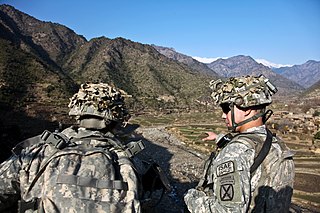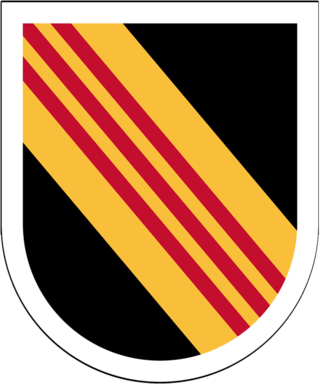
Operation Enduring Freedom (OEF) was the official name used by the U.S. government for both the first stage (2001–2014) of the War in Afghanistan (2001–2021) and the larger-scale Global War on Terrorism. On 7 October 2001, in response to the September 11 attacks, President George W. Bush announced that airstrikes targeting Al-Qaeda and the Taliban had begun in Afghanistan. Beyond the military actions in Afghanistan, Operation Enduring Freedom was also affiliated with counterterrorism operations in other countries, such as OEF-Philippines and OEF-Trans Sahara.

Gul Agha Sherzai, also known as Mohammad Shafiq, is a politician in Afghanistan. He is the former governor of Nangarhar province in eastern Afghanistan. He previously served as Governor of Kandahar province, in the early 1990s and from 2001 until 2003. In October 2013, Sherzai resigned from his post as governor and formally announced himself as a candidate for Afghanistan's 2014 Presidential Election, and served as the minister of border and tribal affairs until the Taliban victory in 2021.

Shortly after the September 11 attacks, the United States declared the beginning of the war on terror and subsequently led a multinational invasion of Taliban-ruled Afghanistan. The stated goal was to dismantle al-Qaeda, which had executed the attacks under the leadership of Osama bin Laden, and to deny Islamist militants a safe base of operations in Afghanistan by toppling the Taliban government. The United Kingdom was a key ally of the United States, offering support for military action from the start of the invasion preparations. The American military presence in Afghanistan greatly bolstered the Northern Alliance, which had been locked in a losing fight with the Taliban during the Afghan Civil War. Prior to the beginning of the United States' war effort, the Taliban had seized around 85% of Afghanistan's territory as well as the capital city of Kabul, effectively confining the Northern Alliance to Badakhshan Province and smaller surrounding areas. The American-led invasion on October 7, 2001, marked the first phase of what would become the 20-year-long War in Afghanistan and was the technical start of the War on Terror.
Tarīnkōṭ, also spelled as Tarin Kowt, is the capital of Uruzgan Province in southern Afghanistan in the Tarinkot District. Tarinkot city has a population of 71,604 (2015), with some 200 small shops in the city's bazaar.
Operation Mountain Thrust was a NATO and Afghan-led operation in the War in Afghanistan, with more than 3,300 British troops, 2,300 U.S., 2,200 Canadian troops, about 3,500 Afghan soldiers and large air support. Its primary objective was to quell the ongoing Taliban insurgency in the south of the country.

In January 2006, NATO's focus in southern Afghanistan was to form Provincial Reconstruction Teams with the British leading in Helmand Province and the Netherlands, Australia and Canada leading similar deployments in Orūzgān Province and Kandahar Province respectively. The United States, with 2,200 troops, stayed in control of Zabul Province. Local Taliban figures voiced opposition to the incoming force and pledged to resist it.

The 5th Special Forces Group (Airborne) (5th SFG (A), 5th Group) is one of the most decorated active duty United States Army Special Forces groups. The 5th SFG (A) saw extensive action in the Vietnam War and played a pivotal role in the early months of Operation Enduring Freedom. 5th Group is designed to deploy and execute nine doctrinal missions: unconventional warfare, foreign internal defense, direct action, counter-insurgency, special reconnaissance, counter-terrorism, information operations, counterproliferation of weapon of mass destruction, and security force assistance.
The following lists events that happened during 2002 in Afghanistan.
The following lists events that happened during 2004 in Afghanistan.

US and NATO International Security Assistance Force (ISAF) operations, alongside Afghan National Army forces, continued against the Taliban through 2007.
United States and NATO International Security Assistance Force (ISAF) operations, alongside Afghan National Army forces, continued against the Taliban through 2008.
The Battle of Tarinkot took place in 2001 during the War in Afghanistan. On November 14, 2001, ODA 574 and Hamid Karzai inserted into Uruzgan Province via 4 MH-60K helicopters with a small force of guerrillas. In response to the approach of Karzai's force, the inhabitants of the town of Tarinkot revolted and expelled their Taliban administrators. Karzai traveled to Tarinkot to meet with the town elders. While he was there, the Taliban marshaled a force of 500 men to retake Tarinkot. Karzai's small force plus the American contingent, which consisted of US Army Special Forces from ODA 574 and their US Air Force Combat Controller, Tech Sergeant Alex Yoshimoto, were deployed in front of the town to block their advance. Relying heavily on close air support directed by Yoshimoto, the American/Afghan force managed to halt the Taliban advance and drive them away from the town.

The Fall of Kandahar took place in 2001 during the War in Afghanistan. After the fall of Mazar-i-Sharif, Kabul and Herat, Kandahar was the last major city under Taliban control. Kandahar was where the Taliban movement had originated and where its power base was located, so it was assumed that capturing Kandahar would be difficult. The city fell after several weeks of fighting to a force of local militia under Pashtun military commanders and their American advisers. The fall of Kandahar signaled the end of organized Taliban control of Afghanistan.
Operation Moshtarak, also known as the Battle of Marjah, was an International Security Assistance Force (ISAF) pacification offensive in the town of Marjah, Helmand Province, Afghanistan. It involved a combined total of 15,000 Afghan, American, British, Canadian, Danish, and Estonian troops, constituting the largest joint operation of the War in Afghanistan up to that point. The purpose of the operation was to remove the Taliban from Marja, thus eliminating the last Taliban stronghold in central Helmand Province. The main target of the offensive was the town of Marjah, which had been controlled for years by the Taliban as well as drug traffickers.
The Battle of Shawali Kowt took place near the Arghandab River in Afghanistan during the Invasion of Afghanistan. On December 2, 2001, after a pitched street-by-street battle, the Green Berets and Afghan Freedom Fighters captured the town of Shawali Kowt, but could not gain control over a bridge over the Arghandab River, a gateway to the Taliban spiritual center of Kandahar. That night, the Taliban forces launched a major counterattack, triggering a retreat by the Afghans. Over the next eight hours, the American forces defended against the retreat. U.S. Air Force Sergeant Alex Yoshimoto, the combat controller, orchestrated numerous air strikes from a variety of fighters and bombers, thwarting the Taliban charge and forcing the enemy to retreat.
The Battle of Sayyd Alma Kalay that took place near the Arghandab River in Afghanistan during the United States invasion of Afghanistan. The Taliban were defeated by the United States and its Afghan allies, setting the stage for the Fall of Kandahar.
Jason Amerine is a retired lieutenant colonel in the United States Army Special Forces. He served in the Invasion of Afghanistan in 2001, in which he aided tribal leader Hamid Karzai in fighting a guerrilla war against the Taliban. For bravery in the invasion, he was awarded the Bronze Star Medal and the Purple Heart. He was also a "Real Hero" in the America's Army video game.

The Sayyd Alma Kalayy airstrike was a major friendly fire incident via airstrike during the Invasion of Afghanistan. It happened on December 5, 2001 when a U.S. soldier responsible for calling in airstrikes accidentally misguided the Boeing B-52 bomber to strike a hill held by American Special Forces and dozens of their Afghan allies.

The U.S. Army Special Forces traces its roots as the Army's premier proponent of unconventional warfare from purpose-formed special operations units like the Alamo Scouts, Philippine guerrillas, First Special Service Force, and the Operational Groups (OGs) of the Office of Strategic Services. Although the OSS was not an Army organization, many Army personnel were assigned to the OSS and later used their experiences to influence the forming of Special Forces.

America's Response Monument, subtitled De Oppresso Liber, is a life-and-a-half scale bronze statue in Liberty Park overlooking the National September 11 Memorial & Museum in New York City. Unofficially known as the Horse Soldier Statue, it is the first publicly accessible monument dedicated to the United States Army Special Forces. It was also the first monument near Ground Zero to recognize heroes of the September 11 terrorist attacks.










